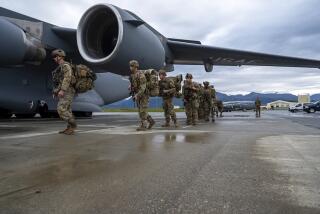Navy Practices Its Response to Hostile Foreign Crowds
- Share via
A year after a terrorist attack killed 17 sailors aboard a U.S. ship docked in the Middle East and traumatized the American public, the Navy has made “force protection” a top priority.
As part of various stratagems and weapons being developed in laboratories and bases across the country, an exercise was held Thursday at the Port Hueneme base in Ventura County designed to train sailors how to thwart a hostile mob in a foreign port.
Sailors aboard the frigate Rentz and guided missile destroyer Russell blasted the mock protesters with pepper-ball guns and fire hoses.
In an eerie replay of the boat attack on the guided missile destroyer Cole while it was docked in Yemen, two small rubber craft raced toward the ships. The air filled with the popping of pepper balls.
Still Vulnerable to Terrorism
It is one of the ironies of the new century: Although the United States is unmatched as a superpower, it is still vulnerable to a terrorist with explosives and a death wish.
“There are a lot of groups--not just Osama bin Laden--who are totally anti-United States and are planning and scheming all the time,” said Gary Ackerman, terrorist expert at the Center for Nonproliferation Studies at the Monterey Institute of International Studies. “It’s a pretty bleak picture; these groups are not going to stop.”
Terrorists are betting that the United States will retreat from overseas commitments rather than see its military personnel killed, he said.
Although much of the emphasis has been on threats to ships docking in foreign ports, the Navy has increased security for ships at U.S. ports, including San Diego, one of its most crowded home ports.
Among other measures the Navy has built additional guard towers and deployed more boats and armed guards. The service is also experimenting with floating barriers to keep terrorists from ramming explosive-laden boats into San Diego-based ships.
Eric Thompson, an analyst with the Washington-based Center for Naval Analysis, said he has been impressed with “how very comprehensive the Navy’s approach to force protection” has become since the Cole disaster.
Among other things, he said, the service has beefed up training, worked closer with allies and explored technological innovations to detect and thwart terrorist attacks.
“The Navy has been concerned about threats from small craft for a long time, not just in port but swarms of craft attacking at sea,” said Andrew Koch, Washington bureau chief for Jane’s Defence Weekly. “The Cole incident gave it a political jump forward, and because of that, a lot more resources are available now to find solutions.”
In February, the Navy deployed several unmanned mini-aircraft, called Dragon Eye, to the fleet in the Middle East for use in intelligence gathering.
The Marine Corps is experimenting with a Vehicle-Mounted Active Denial System that would use ultra-hot microwaves to keep hostile ships from approaching Navy vessels or other U.S. military facilities.
Navy researchers also are trying to develop a kind of bulletproof shield that could be draped over vulnerable parts of a ship when it is in a foreign port. The shield would cushion the ship against a terrorist bomb carried by a boat like the one that hit the Cole.
Along with the use of paint and water, the Port Hueneme exercise offered a chance to test a new military Web site meant to provide ship commanders with up-to-date intelligence about what threats await them in foreign ports.
‘A Real Challenge’ to Coordinate Effort
Cmdr. Thomas Beall, skipper of the San Diego-based Rentz, called the exercise realistic.
“Trying to coordinate this [defense] was a real challenge,” he said. “Today taught me the value of good intelligence.”
The “protesters,” volunteers from the nearby U.S. Navy Seabee base, were supposed to be angry that the fictional “Blue” country had come to their nation.
“GI, you go home!” Seabee Clarke Jeffers screamed through a loudspeaker. “You come to our country; you kill our people!”
Three men lunged from the crowd carrying fake hand grenades and were quickly blasted with pepper-ball guns.
Sailors who fired the pepper balls seemed unfazed by the attack and said they were ready if the practice scenario ever became a reality.
“We are protecting our ship,” said Chief Gunner’s Mate Sean Howarth. “When we are away from port, this ship is our home.”
More to Read
Sign up for Essential California
The most important California stories and recommendations in your inbox every morning.
You may occasionally receive promotional content from the Los Angeles Times.










